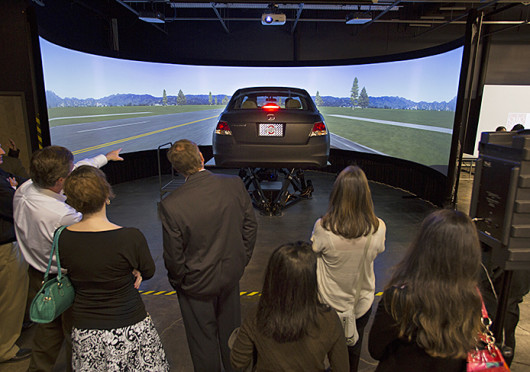
The OSU Driving Simulation Laboratory, located at 1305 Kinnear Road, is set to be used as part of a $4.3M grant to research crash imminent situations and vehicle safety.
Credit: Courtesy of Janet Weisenberger
Self-operating vehicles will join manually operated cars in the coming years, according to some Ohio State researchers, raising questions about what would happen if an accident happened without a driver in control.
Janet Weisenberger, OSU senior associate vice president for research, said those are the questions researchers are focusing on answering.
“In a situation where a crash is imminent, when does the vehicle take over? Should the vehicle ever give control back to the human driver? How does the human driver react when the vehicle takes over?” Weisenberger said. “Those are the kinds of questions we will be working on answering.”
Researchers from various fields of study are coming together to launch a $4.3 million center to study crash-imminent situations in autonomous, or self-driving cars, with the help of a grant from the U.S. Department of Transportation.
The grant was awarded to develop a Crash Imminent Safety University Transportation Center, although Umit Ozguner, a professor of electrical and computer engineering and head of the research center, said in an email that the center does not refer to an actual building but an “umbrella organization.” That organization includes existing research facilities, like the driving simulator, at both OSU and its partner universities. The grant money will be used to fund the research taking place in these facilities.
Ozguner said the center will hopefully launch next month.
For the grant, OSU is partnering with Indiana University-Purdue University Indianapolis, North Carolina A&T State University, University of Massachusetts-Amherst and University of Wisconsin-Madison. Researchers will collaborate and communicate via teleconference meetings. Ozguner said there are about a dozen faculty and staff members listed on the proposal, but he expects that number to double with student and graduate student research assistants.
Ozguner said the Department of Transportation gathers proposals for university transportation centers that plan to advance technology in transportation through research. He said he believes the team’s proposal, along with OSU’s “history of involvement in transportation research,” aligned with the Department of Transportation’s goals.
The university will receive more than $1.4 million for 2013, and the team has requested $1.5 million for next year. Cost sharing with the university will make up the rest of the $4.3 million total over the first two years, Weisenberger said.
Weisenberger said the research team is donating a majority of the university’s portion of the cost, including personnel time and equipment usage.
Ozguner said he has been studying autonomous cars for years as part of the OSU Control and Intelligent Transportation Research Lab. He said designing the cars’ synthetic intelligence involves understanding real human driving behaviors, which is why the grant-awarded team includes experts from other related fields.
“Without collaborating with true experts, it would just be my guess at how humans drive,” he said. “Especially if the autonomous cars will be in mixed traffic, we need to understand what the other (human) drivers might do, particularly if a crash is imminent. Similarly, we need to understand the biomechanics aspects if we are to design with new driving, sensing and sitting configurations.”
Weisenberger is also the director of OSU’s Driving Simulation Laboratory, which studies drivers’ behavior. As part of the study, she plans to simulate crashes and measure responses of real drivers in the simulator — for example, if people could be “lulled” by a car that drives itself and not respond fast enough to a crash situation.
“It’s important to understand how humans interact with these autonomous systems in ways that will actually enhance driver safety,” she said.
John Bolte, director of the OSU Wexner Medical Center Injury Biomechanics Research Center and a member of the research team, said in an email his lab will study reports of real world crashes and resulting injuries to determine if injury data can suggest potential evasive actions by the driver or car that would minimize harm.
“We hypothesize that injury data from a particular crash scenario can suggest situations in which the driver should not re-engage and assume control of the vehicle but rather leave the autonomous system in control, because human motor skill or reaction time would be insufficient to mitigate injury,” Bolte said.
At the end of the two-year grant, Weisenberger said the research team plans to reapply.
Ozguner said research “never is truly completed,” but the team does have long-term goals it’s working toward.
“(Research) could lead to new regulations related to autonomous cars on the road, or specific new sensors in cars, or some real-time algorithm to quantify safety,” he said. “Ultimately we want safer roads and a safer driving experience.”


